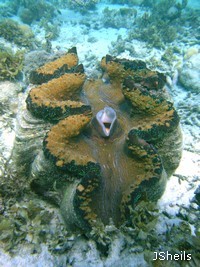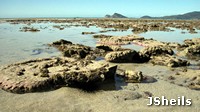





.jpg)

.jpg)
.jpg)
.jpg)






Protected mollusc species
Giant clams (Tridacna spp.)
Heavyweights of the mollusc world
Giant clams (Tridacna spp.)
Heavyweights of the mollusc world
Giant clams are bivalve molluscs; this refers to their two piece shell, which is hinged at the base. The largest species, Tridacna gigas, is the biggest and heaviest bivalve species ever to have lived, reaching up to 1.3m long and 300kg in weight.
Their massive shells have annual growth layers which can be used to work out the age of the clam after it dies: they may live as long as 100 years. Smaller species attach themselves to the reef's surface with byssal threads, but T. gigas is held in place just by the weight of its shell.
Like other bivalve shells, giant clams can form pearls when an irritating particle becomes stuck inside the clam's mantle. The pearls are porcelain-white, like the inside of the clam shell, and have been found up to 6kg in weight.
Of what are thought to be 8 species of giant clam in the world, 6 are found on the Great Barrier Reef. All six of these species are found in the Whitsunday region.
Solar powered animals
Giant clams are truly solar powered animals. Most bivalve molluscs open only slightly to draw in food and water, keeping their shells partially closed for protection from predators. Giant clams dare to be different; they have modified their bodies to allow them to open up as wide as possible and expose as much of their mantle, (the colourful lips of the clam), as they can to the sun.
This seemingly risky strategy makes sense once you know that that they must have sunlight to grow; they are literally solar powered. This restricts them to the top 20m of water, but allows them to get the energy they need to reach their huge size and build their massive shells.
Giant clams share a symbiotic partnership with the same single-celled algae (zooxanthellae) that reef-building corals have living inside their bodies. In giant clams the zooxanthellae live in delicate tubes of gut tissue that extend into the colourful mantle that you see protruding from the clam's shell.
As the zooxanthellae absorb sunlight, they turn this energy into sugars and proteins, which they share with the clam. This relationship works so well for the giant clams that they only filter less than 10% of their food from the water; they are dependant on their zooxanthellae and without sunlight they can't feed themselves.
Watching out for danger
Although their soft mantle tissues are exposed and seemingly an easy target for predators, giant clams can see danger coming. Around the edge of the clam's mantle there is a row of tiny black dots, called ocelli, which are the closest thing to eyes that a clam has. They can use these to sense changes in light levels, like the shadow of a fish passing by (or someone trying to photograph the clam!), and anytime something gets too close the clam will react by 'twitching' it's shell.
This movement is usually enough to scare off most things: giant clams can't close quickly as they have to expel a lot of water from inside to do so. Some of the really big ones have such bulky bodies that it is very difficult for them to close fully at all. Clams that grow on the top of the reef flat, where they are exposed to the air at low tide, will close to protect themselves from drying out, squirting jets of water high into the air as they do so.
Works of art: clam variety
The colours and patterns of the lips of the giant clams make them one of the Reef's most spectacularly colourful animals. Each is slightly different; within the same species you can find a range of different colours and patterns. Scientists use the structure of the clam's shell, not the colour of the animal, to identify the species.
Large species like T. gigas grow fastest in the early years of their lives, reaching a size that puts them out of reach of many potential predators in their first few years. Smaller species, such as T. crocea embed themselves in the surface of the reef for protection, and don't grow as large. Hippopus hippopus, the Horseshoe clam, is the only species of giant clam placed in a genus by itself and has a distinctive shaped shell with an indentation like a hoof-print in one end.
Sex and the single clam
If you look closely at a giant clam, you will see two openings in the mantle, the siphons, which the clam uses to draw water in and out, to get oxygen and food. If you are looking around spawning season you may be lucky enough to see the clam seemingly go into convulsions and eject a cloud of eggs or sperm!
Giant clams start breeding at 9-10 years old and start life as males, later becoming hermaphrodites: both male and female, although eggs and sperm are released at different times. Clams can sense the eggs and sperm of other clams in the water, which can set off a chain-reaction of spawning; an adult T. gigas can release several million of eggs.
Fertilised eggs become planktonic larvae, which travel in the surface waters feeding on phytoplankton, as they have no zooxanthellae at this stage. They will settle to the reef's surface after about 9 days, and can move about for the first few weeks in search of a good spot. During this stage they are too small to be visible. At this stage they ingest the zooxanthellae from the plankton that they will depend on for the rest of their lives.
Threats
Poaching removed thousands of giant clams from the northern Great Barrier Reef in the 1970s. Taking giant clams for food has led to the extinction of T. gigas from many reefs in the Pacific. Australia and the Solomon Islands have the last abundant populations of this species, which is listed as Vulnerable by the IUCN.
Giant Triton shell (Charonia tritonis)
God of the sea-snails?
Also known as Trumpet shells, they were named after the the Greek God Triton, son of Poseidon. Giant tritons are predatory snails, found throughout the Indo-Pacific region and can reach up to to 50cm long.
Giant tritons are famous for their ability to eat the poisonous, spiny Crown of Thorns starfish. They are thought help control the numbers of adult Crown of Thorns starfish on coral reefs. They also feed on other starfish and molluscs. They are active predators, detecting their prey by smell and rapidly following it. Once the snail catches up with its prey it envelops it with its muscular foot and scrapes away at its flesh using a file-like radula.
Reproduction
Giant tritons have separate males and females. Females lay clusters of egg capsules, each containing multiple larvae. When the larvae hatch, they spend the next few months in the plankton, before settling on a reef and becoming adult snails.
Helmet shells (Cassis cornuta)
Big but hard to see
Cassis cornuta is the largest of all Helmet shells, growing up to 35cm long. They are slow-moving, carnivorous snails which live in sandy habitats near coral reefs, from the intertidal zone down to considerable depths.
They mainly hunt at night, preying on echinoderms such as sea urchins or starfish, often completing the whole operation without emerging from under the sand! This might be one reason why they are rarely seen. They can even eat poisonous Crown of Thorns seastars, potentially helping to protect reefs from outbreaks.
Fearsome predators
Once a helmet shell finds an unfortunate urchin, it envelops it with its leathery foot and squirts a dose of neurotoxic saliva over it. This paralyses the spines of the urchin and allows the snail to insert its snout into the urchin's anus, or through a hole that it rasps through the urchin's test using its file-like radula. The sheer size of the helmet shell can physically crush the test of the sea urchin during this process, making it even easier for it to eat the soft flesh inside.
Reproduction
Helmet shells are either male or female and females are often larger than the males. After mating, the females lay large masses of eggs which are leathery, cylindrical structures, made up of many individual capsules. Each capsule contains several hundred eggs, but most of these end up as food for their developing siblings.
Human uses
The large size of these snails make them targets for collecting for food and for their spectacular shells, which are sold to collectors and tourists. The shells are also used to make lime and for the carving of cameos.
Helmet shells are listed as 'data deficient' in Queensland, meaning that little is known about their population, or where they occur.
Threats to protected mollusc species
- Over harvesting in areas where they are not protected
- Disturbance of habitat and destruction of eggs by careless fossickers
- Loss of feeding habitat due to poor water quality
- Climate change threatens molluscs by threatening the reef habitats that they depend on for food and shelter
How you can help protected mollusc species...
- Be careful when you explore the fringing reefs: try not to disturb molluscs and please don't hassle the clams!
- If you look under a boulder on the reef, put it back where you found it. Exposed animals & mollusc eggs will die.
- Don't buy imported mollusc shells: every shell was once a live snail.
- Support measures to improve Reef water quality, join your local Landcare group
- Water quality begins at home (and at work...)! Remember that the chemicals you use will ultimately end up in the sea. Use environmentally friendly chemicals; avoid artificial herbicides and pesticides if you can. If you have to use harmful chemicals, follow the instructions on the label carefully and avoid uses that might let chemicals wash into drains or waterways.
More information:
GBRMPA Responsible Reef Practices:
Get involved: report protected species sightings:
Volunteer groups:
More information
Giant clams
Animal Diversity Web: Giant clams
Aquasearch: Giant Clam aquaculture
Lizard Island Research Station: Giant clam, T. gigas
Review paper: Distribution and status of giant clams (family Tridacnidae)
Giant triton shell
Queensland Museum: Giant triton
You-tube video of a Giant triton eating a Crown of Thorns Starfish
Reef CRC: Giant triton shells and Crown of Thorns Starfish Outbreaks
Biodiversity India: Giant Triton
World Register of Marine Species: Giant Triton
Encyclopaedia of Life Online: Giant Triton
Helmet shell


